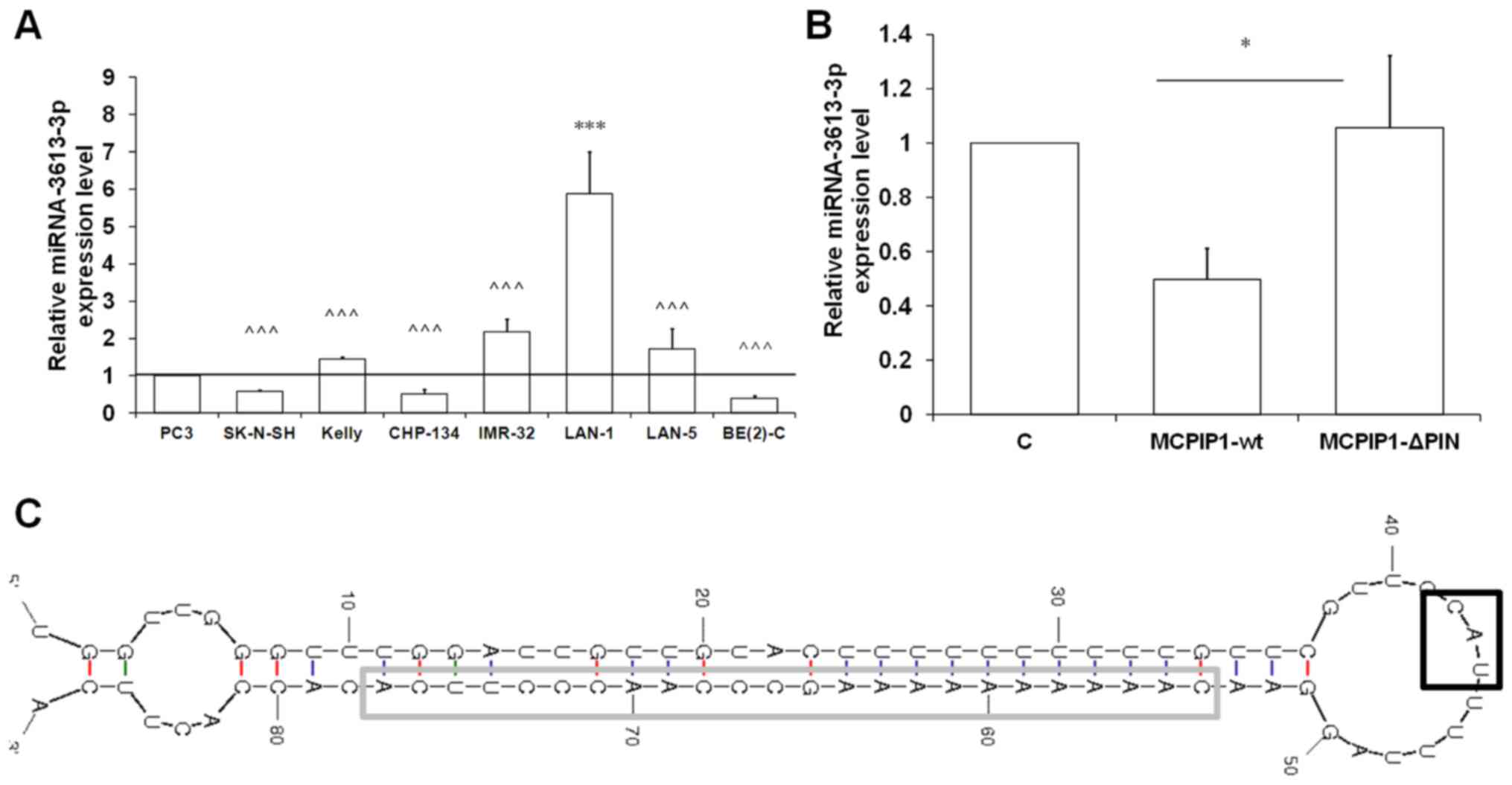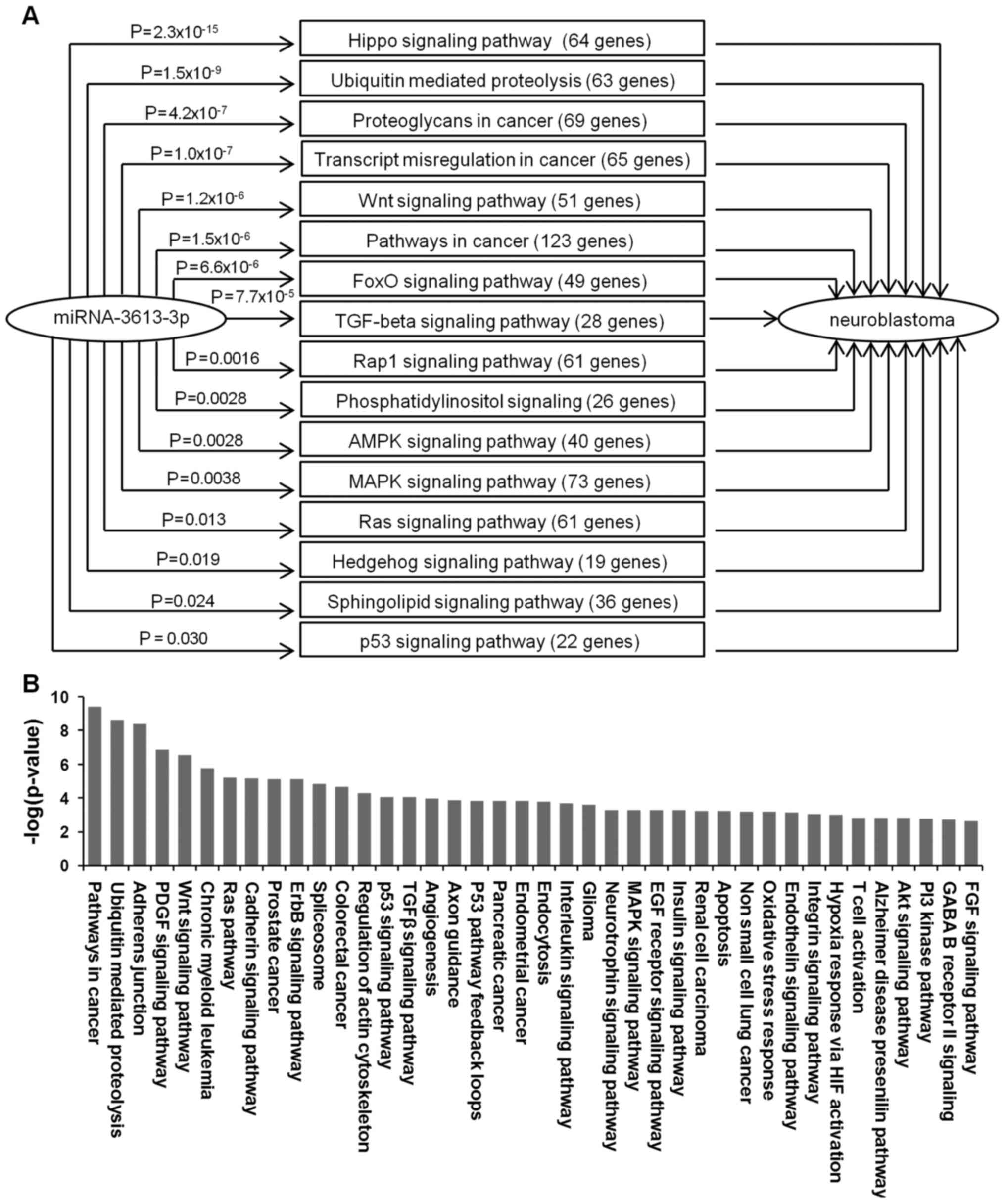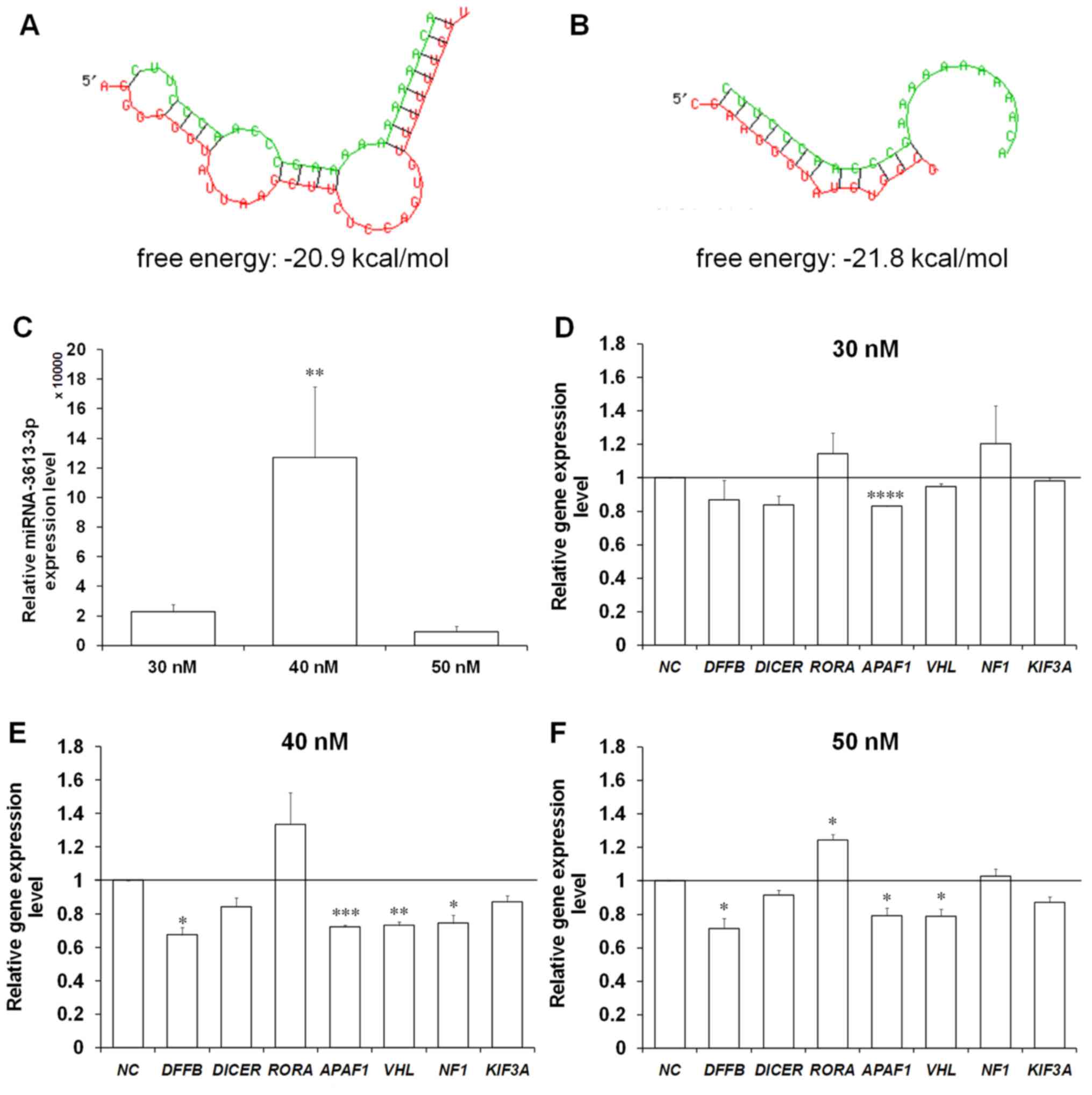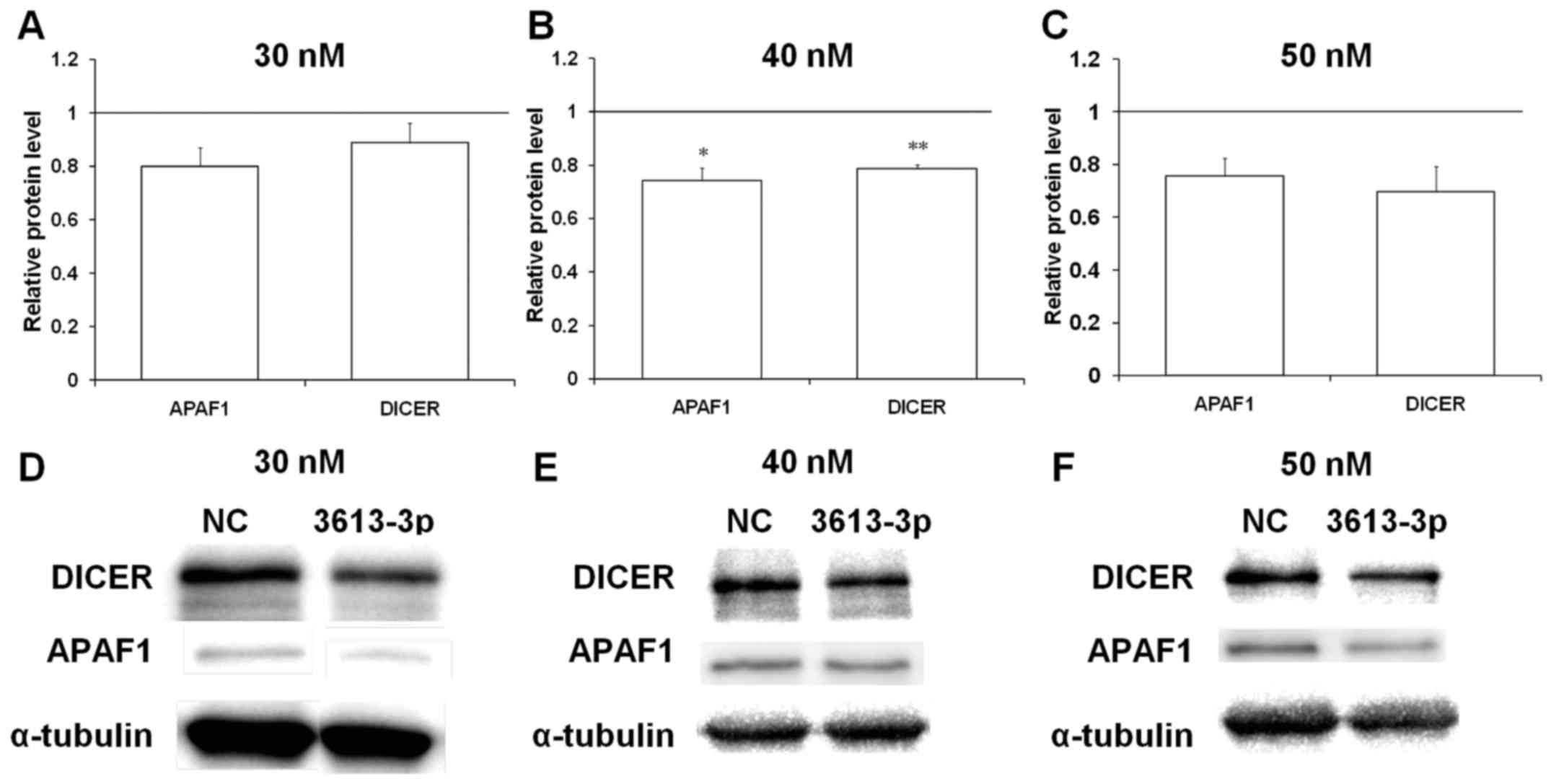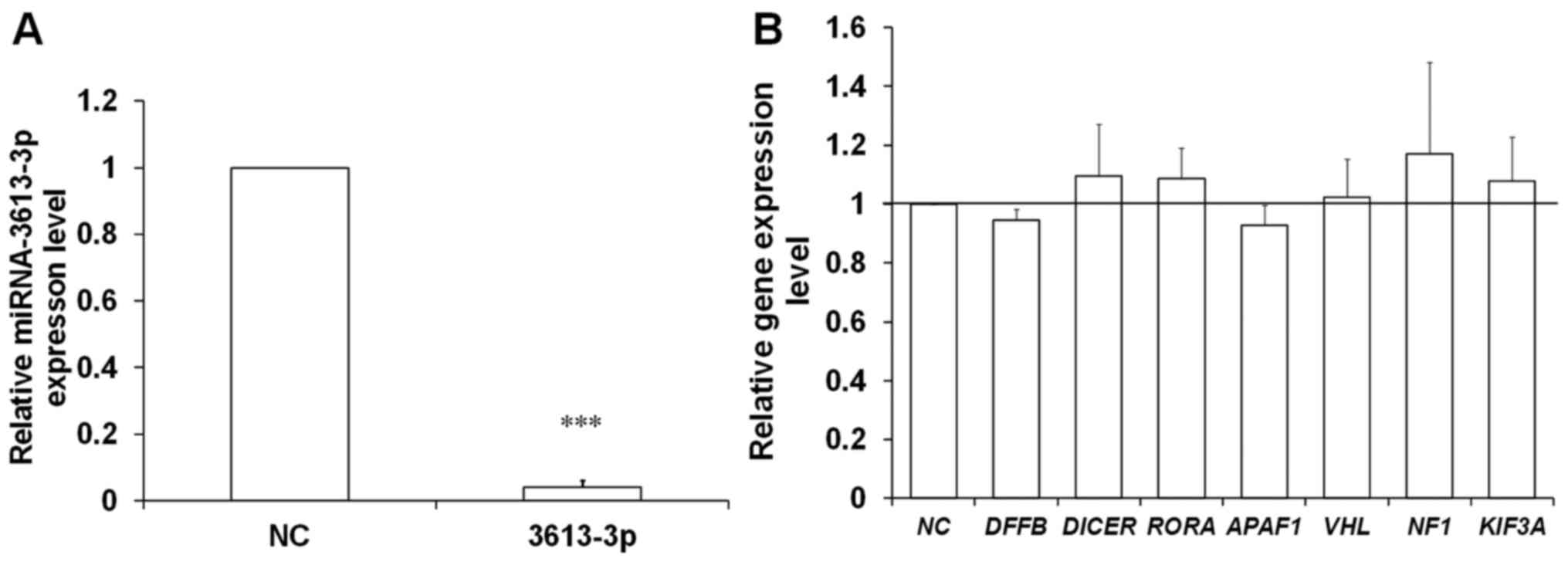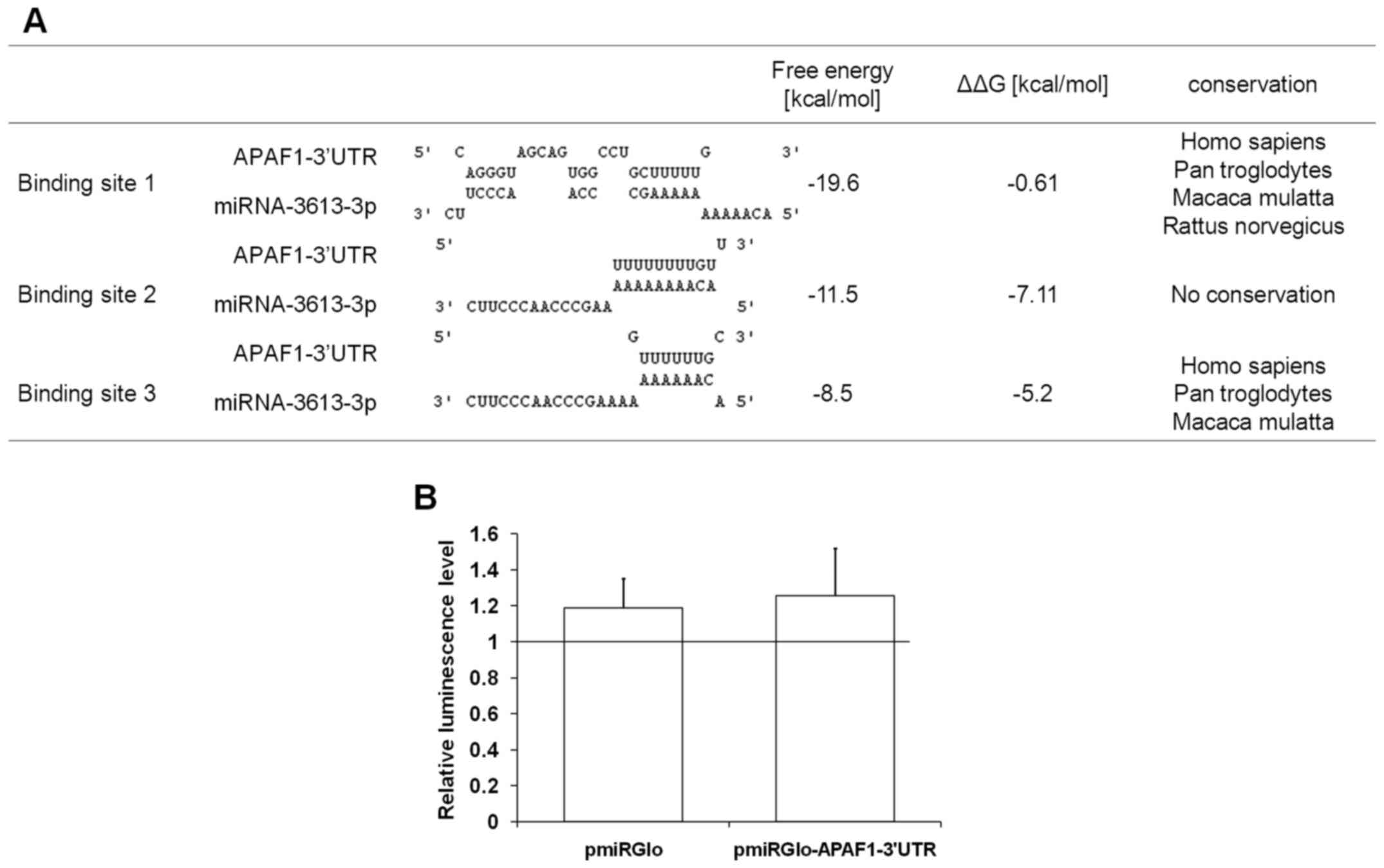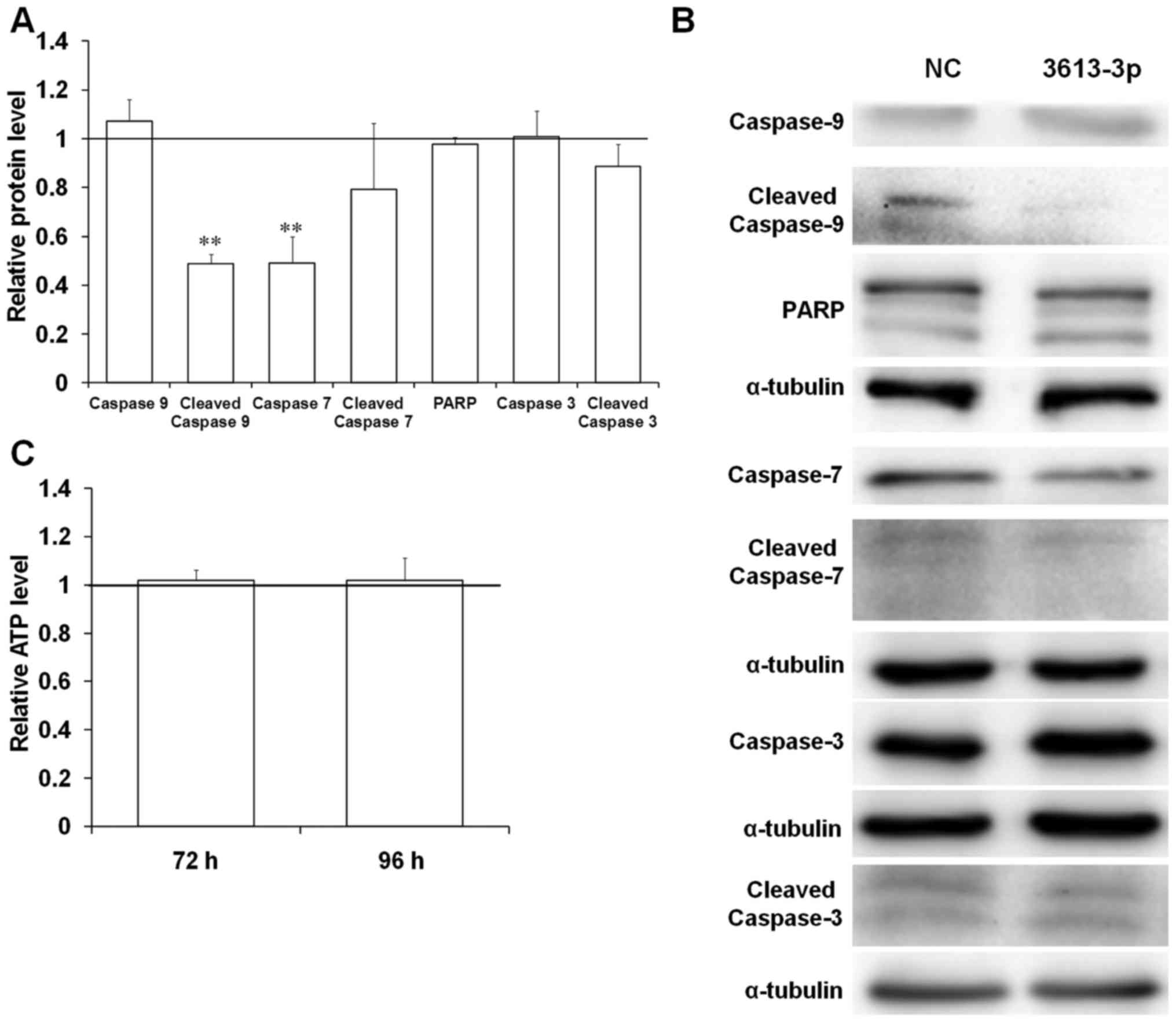|
1
|
Louis CU and Shohet JM: Neuroblastoma:
Molecular pathogenesis and therapy. Annu Rev Med. 66:49–63. 2015.
View Article : Google Scholar :
|
|
2
|
Maris JM, Hogarty MD, Bagatell R and Cohn
SL: Neuroblastoma. Lancet. 369:2106–2120. 2007. View Article : Google Scholar : PubMed/NCBI
|
|
3
|
Pinto NR, Applebaum MA, Volchenboum SL,
Matthay KK, London WB, Ambros PF, Nakagawara A, Berthold F,
Schleiermacher G, Park JR, et al: Advances in risk classification
and treatment strategies for neuroblastoma. J Clin Oncol.
33:3008–3017. 2015. View Article : Google Scholar : PubMed/NCBI
|
|
4
|
de Carvalho IN, de Freitas RM and Vargas
FR: Translating microRNAs into biomarkers: What is new for
pediatric cancer? Med Oncol. 33:492016. View Article : Google Scholar : PubMed/NCBI
|
|
5
|
Zhi F, Wang R, Wang Q, Xue L, Deng D, Wang
S and Yang Y: MicroRNAs in neuroblastoma: Small-sized players with
a large impact. Neurochem Res. 39:613–623. 2014. View Article : Google Scholar : PubMed/NCBI
|
|
6
|
Mei H, Lin ZY and Tong QS: The roles of
microRNAs in neuroblastoma. World J Pediatr. 10:10–16. 2014.
View Article : Google Scholar : PubMed/NCBI
|
|
7
|
Boratyn E, Nowak I, Horwacik I, Durbas M,
Mistarz A, Kukla M, Kaczówka P, Łastowska M, Jura J and Rokita H:
Monocyte chemoattractant protein-induced protein 1 overexpression
modulates transcriptome, including microRNA, in human neuroblastoma
cells. J Cell Biochem. 117:694–707. 2016. View Article : Google Scholar
|
|
8
|
Liu H, Chen G, Liang M, Qin H, Rong J, Yao
J and Wu Z: Atrial fibrillation alters the microRNA expression
profiles of the left atria of patients with mitral stenosis. BMC
Cardiovasc Disord. 14:102014. View Article : Google Scholar : PubMed/NCBI
|
|
9
|
Ji H, Chen M, Greening DW, He W, Rai A,
Zhang W and Simpson RJ: Deep sequencing of RNA from three different
extracellular vesicle (EV) subtypes released from the human LIM1863
colon cancer cell line uncovers distinct miRNA-enrichment
signatures. PLoS One. 9:e1103142014. View Article : Google Scholar : PubMed/NCBI
|
|
10
|
Wang N, Bu R, Duan Z, Zhang X, Chen P, Li
Z, Wu J, Cai G and Chen X: Profiling and initial validation of
urinary microRNAs as biomarkers in IgA nephropathy. PeerJ.
3:e9902015. View Article : Google Scholar : PubMed/NCBI
|
|
11
|
Pu Q, Huang Y, Lu Y, Peng Y, Zhang J, Feng
G, Wang C, Liu L and Dai Y: Tissue-specific and plasma microRNA
profiles could be promising biomarkers of histological
classification and TNM stage in non-small cell lung cancer. Thorac
Cancer. 7:348–354. 2016. View Article : Google Scholar : PubMed/NCBI
|
|
12
|
Kumar S, Vijayan M and Reddy PH:
MicroRNA-455-3p as a potential peripheral biomarker for Alzheimer's
disease. Hum Mol Genet. 26:3808–3822. 2017. View Article : Google Scholar : PubMed/NCBI
|
|
13
|
Singh A, Rooge S, Varshney A, Vasudevan M,
Bhardwaj A, Venugopal S, Trehanpati N, Kumar M, Geffers R, Kumar V,
et al: Global micro RNA expression profiling in the liver biopsies
of Hepatitis B virus infected patients suggests specific miRNA
signatures for viral persistence and hepatocellular injury.
Hepatology. 67:1695–1709. 2017. View Article : Google Scholar
|
|
14
|
Zhang D, Liu E, Kang J, Yang X and Liu H:
MiR-3613-3p affects cell proliferation and cell cycle in
hepatocellular carcinoma. Oncotarget. 8:93014–93028.
2017.PubMed/NCBI
|
|
15
|
Zhang Y, Kang R, Liu W, Yang Y, Ding R,
Huang Q, Meng J, Xiong L and Guo Z: Identification and analysis of
p53-mediated competing endogenous RNA network in human
hepatocellular carcinoma. Int J Biol Sci. 13:1213–1221. 2017.
View Article : Google Scholar : PubMed/NCBI
|
|
16
|
Mizgalska D, Wegrzyn P, Murzyn K, Kasza A,
Koj A and Jura J, Jarzab B and Jura J: Interleukin-1-inducible
MCPIP protein has structural and functional properties of RNase and
participates in degradation of IL-1beta mRNA. FEBS J.
276:7386–7399. 2009. View Article : Google Scholar : PubMed/NCBI
|
|
17
|
Boratyn E, Nowak I, Durbas M, Horwacik I,
Sawicka A and Rokita H: MCPIP1 exogenous overexpression inhibits
pathways regulating MYCN oncoprotein stability in neuroblastoma. J
Cell Biochem. 118:1741–1755. 2017. View Article : Google Scholar
|
|
18
|
Livak KJ and Schmittgen TD: Analysis of
relative gene expression data using real-time quantitative PCR and
the 2(-ΔΔC(T)) method. Methods. 25:402–408. 2001. View Article : Google Scholar
|
|
19
|
Smith PK, Krohn RI, Hermanson GT, Mallia
AK, Gartner FH, Provenzano MD, Fujimoto EK, Goeke NM, Olson BJ and
Klenk DC: Measurement of protein using bicinchoninic acid. Anal
Biochem. 150:76–85. 1985. View Article : Google Scholar : PubMed/NCBI
|
|
20
|
Horwacik I, Durbas M, Boratyn E, Węgrzyn P
and Rokita H: Targeting GD2 ganglioside and aurora A kinase as a
dual strategy leading to cell death in cultures of human
neuroblastoma cells. Cancer Lett. 341:248–264. 2013. View Article : Google Scholar : PubMed/NCBI
|
|
21
|
Vlachos IS, Zagganas K, Paraskevopoulou
MD, Georgakilas G, Karagkouni D, Vergoulis T, Dalamagas T and
Hatzigeorgiou AG: DIANA-miRPath v3.0: Deciphering microRNA function
with experimental support. Nucleic Acids Res. 43:W460–6. 2015.
View Article : Google Scholar : PubMed/NCBI
|
|
22
|
Paraskevopoulou M, Georgakilas G,
Kostoulas N, Vlachos I, Vergoulis T, Reczko M, Filippidis C,
Dalamagas T and Hatzigeorgiou A: DIANA-microT web server v5.0:
service integration into miRNA functional analysis workflows.
Nucleic Acids Res. 41:W169–W173. 2013. View Article : Google Scholar : PubMed/NCBI
|
|
23
|
Dweep H and Gretz N: miRWalk2.0: A
comprehensive atlas of microRNA-target interactions. Nat Methods.
12:6972015. View Article : Google Scholar : PubMed/NCBI
|
|
24
|
Rehmsmeier M, Steffen P, Hochsmann M and
Giegerich R: Fast and effective prediction of microRNA/target
duplexes. RNA. 10:1507–1517. 2004. View Article : Google Scholar : PubMed/NCBI
|
|
25
|
Kertesz M, Iovino N, Unnerstall U, Gaul U
and Segal E: The role of site accessibility in microRNA target
recognition. Nat Genet. 39:1278–1284. 2007. View Article : Google Scholar : PubMed/NCBI
|
|
26
|
Agarwal V, Bell GW, Nam JW and Bartel DP:
Predicting effective microRNA target sites in mammalian mRNAs.
eLife. 4:e050052015. View Article : Google Scholar :
|
|
27
|
Hessvik NP, Phuyal S, Brech A, Sandvig K
and Llorente A: Profiling of microRNAs in exosomes released from
PC-3 prostate cancer cells. Biochim Biophys Acta. 1819:1154–1163.
2012. View Article : Google Scholar : PubMed/NCBI
|
|
28
|
Chiyomaru T, Yamamura S, Fukuhara S,
Hidaka H, Majid S, Saini S, Arora S, Deng G, Shahryari V, Chang I,
et al: Genistein up-regulates tumor suppressor microRNA-574–3p in
prostate cancer. PLoS One. 8:e589292013. View Article : Google Scholar
|
|
29
|
Sohn EJ, Won G, Lee J, Lee S and Kim SH:
Upregulation of miRNA3195 and miRNA374b mediates the
anti-angiogenic properties of melatonin in hypoxic PC-3 prostate
cancer cells. J Cancer. 6:19–28. 2015. View Article : Google Scholar : PubMed/NCBI
|
|
30
|
Mino T, Murakawa Y, Fukao A, Vandenbon A,
Wessels HH, Ori D, Uehata T, Tartey S, Akira S, Suzuki Y, et al:
Regnase-1 and Roquin regulate a common element in inflammatory
mRNAs by spatiotemporally distinct mechanisms. Cell. 161:1058–1073.
2015. View Article : Google Scholar : PubMed/NCBI
|
|
31
|
Witkos TM, Koscianska E and Krzyzosiak WJ:
Practical aspects of microRNA target prediction. Curr Mol Med.
11:93–109. 2011. View Article : Google Scholar : PubMed/NCBI
|
|
32
|
Shu J, Xia Z, Li L, Liang ET, Slipek N,
Shen D, Foo J, Subramanian S and Steer CJ: Dose-dependent
differential mRNA target selection and regulation by let-7a-7f and
miR-17-92 cluster microRNAs. RNA Biol. 9:1275–1287. 2012.
View Article : Google Scholar : PubMed/NCBI
|
|
33
|
Lin RJ, Lin YC, Chen J, Kuo HH, Chen YY,
Diccianni MB, London WB, Chang CH and Yu AL: microRNA signature and
expression of Dicer and Drosha can predict prognosis and delineate
risk groups in neuroblastoma. Cancer Res. 70:7841–7850. 2010.
View Article : Google Scholar : PubMed/NCBI
|
|
34
|
Cecconi F: Apaf1 and the apoptotic
machinery. Cell Death Differ. 6:1087–1098. 1999. View Article : Google Scholar : PubMed/NCBI
|
|
35
|
Riss T, Moravec R, Niles A, Duellman S,
Benink H, Worzella T and Minor L: Cell Viability Assays in Assay
Guidance Manual. Sittampalam G, et al: Eli Lilly & Company and
the National Center for Advancing Translational Sciences Bethesta,
MD: 2013
|
|
36
|
Stallings RL: MicroRNA involvement in the
pathogenesis of neuroblastoma: Potential for microRNA mediated
therapeutics. Curr Pharm Des. 15:456–462. 2009. View Article : Google Scholar : PubMed/NCBI
|
|
37
|
Shalaby T, Fiaschetti G, Baumgartner M and
Grotzer MA: Significance and therapeutic value of miRNAs in
embryonal neural tumors. Molecules. 19:5821–5862. 2014. View Article : Google Scholar : PubMed/NCBI
|
|
38
|
Tivnan A, Orr WS, Gubala V, Nooney R,
Williams DE, McDonagh C, Prenter S, Harvey H, Domingo-Fernández R,
Bray IM, et al: Inhibition of neuroblastoma tumor growth by
targeted delivery of microRNA-34a using anti-disialoganglioside GD2
coated nanoparticles. PLoS One. 7:e381292012. View Article : Google Scholar : PubMed/NCBI
|
|
39
|
Verissimo CS, Molenaar JJ, Fitzsimons CP
and Vreugdenhil E: Neuroblastoma therapy: What is in the pipeline?
Endocr Relat Cancer. 18:R213–R231. 2011. View Article : Google Scholar : PubMed/NCBI
|
|
40
|
Fontana L, Fiori ME, Albini S, Cifaldi L,
Giovinazzi S, Forloni M, Boldrini R, Donfrancesco A, Federici V,
Giacomini P, et al: Antagomir-17-5p abolishes the growth of
therapy-resistant neuroblastoma through p21 and BIM. PLoS One.
3:e22362008. View Article : Google Scholar : PubMed/NCBI
|
|
41
|
Skalniak A, Boratyn E, Tyrkalska SD,
Horwacik I, Durbas M, Lastowska M, Jura J and Rokita H: Expression
of the monocyte chemotactic protein-1-induced protein 1 decreases
human neuro-blastoma cell survival. Oncol Rep. 31:2385–2392. 2014.
View Article : Google Scholar : PubMed/NCBI
|
|
42
|
Baumann Kubetzko FB, Di Paolo C, Maag C,
Meier R, Schäfer BW, Betts DR, Stahel RA and Himmelmann A: The PAX5
oncogene is expressed in N-type neuroblastoma cells and increases
tumorigenicity of a S-type cell line. Carcinogenesis. 25:1839–1846.
2004. View Article : Google Scholar : PubMed/NCBI
|
|
43
|
Voigt A, Hartmann P and Zintl F:
Differentiation, proliferation and adhesion of human neuroblastoma
cells after treatment with retinoic acid. Cell Adhes Commun.
7:423–440. 2000. View Article : Google Scholar : PubMed/NCBI
|
|
44
|
Ross R: Cellular heterogeneity.
Neuroblastoma. Cheung N and Cohn S: Springer; Berlin: pp. 55–60.
2005, View Article : Google Scholar
|
|
45
|
Liu JA and Cheung M: Neural crest stem
cells and their potential therapeutic applications. Dev Biol.
419:199–216. 2016. View Article : Google Scholar : PubMed/NCBI
|
|
46
|
Judson H, van Roy N, Strain L,
Vandesompele J, Van Gele M, Speleman F and Bonthron DT: Structure
and mutation analysis of the gene encoding DNA fragmentation factor
40 (caspase-activated nuclease), a candidate neuroblastoma tumour
suppressor gene. Hum Genet. 106:406–413. 2000. View Article : Google Scholar : PubMed/NCBI
|
|
47
|
Hanahan D and Weinberg RA: Hallmarks of
cancer: The next generation. Cell. 144:646–674. 2011. View Article : Google Scholar : PubMed/NCBI
|
|
48
|
Campioni M, Santini D, Tonini G, Murace R,
Dragonetti E, Spugnini EP and Baldi A: Role of Apaf-1, a key
regulator of apoptosis, in melanoma progression and
chemoresistance. Exp Dermatol. 14:811–818. 2005. View Article : Google Scholar : PubMed/NCBI
|
|
49
|
Murata H, Tajima N, Nagashima Y, Yao M,
Baba M, Goto M, Kawamoto S, Yamamoto I, Okuda K and Kanno H: Von
Hippel-Lindau tumor suppressor protein transforms human
neuroblastoma cells into functional neuron-like cells. Cancer Res.
62:7004–7011. 2002.PubMed/NCBI
|
|
50
|
Hoebeeck J, Vandesompele J, Nilsson H, De
Preter K, Van Roy N, De Smet E, Yigit N, De Paepe A, Laureys G,
Påhlman S, et al: The von Hippel-Lindau tumor suppressor gene
expression level has prognostic value in neuroblastoma. Int J
Cancer. 119:624–629. 2006. View Article : Google Scholar : PubMed/NCBI
|
|
51
|
Hölzel M, Huang S, Koster J, Ora I,
Lakeman A, Caron H, Nijkamp W, Xie J, Callens T, Asgharzadeh S, et
al: NF1 is a tumor suppressor in neuroblastoma that determines
retinoic acid response and disease outcome. Cell. 142:218–229.
2010. View Article : Google Scholar : PubMed/NCBI
|
|
52
|
Savitskaya MA and Onishchenko GE:
Mechanisms of apoptosis. biochemistry (Mosc). 80:1393–1405. 2015.
View Article : Google Scholar
|















